A Study of the Strategic Interaction in Environmental Regulation Based on Spatial Effects
Abstract
:1. Introduction
2. Research Design
2.1. Methodology
2.1.1. Exploratory Spatial Data Analysis Approach (ESDA)
2.1.2. Setting of the Econometric Model
- 1.
- The spatial lag panel data model:
- 2.
- The spatial error panel data model:
2.2. Data Description and Variable Selection
2.2.1. Variables
- (1)
- Environmental regulation
- (2)
- Decentralized indicators (FD)
- (3)
- Public demand for environmental protection (LETTER)
- (4)
- Other variables
2.2.2. Data
3. Empirical Results and Analysis of the Spatial Effects
3.1. Spatial Correlation
3.1.1. Global Spatial Correlation
3.1.2. Local Spatial Correlation
3.2. Spatial Spillover Effects
- (1)
- Environmental regulation
- (2)
- Fiscal decentralization (FD)
- (3)
- Public environmental demands (LETTER)
- (4)
- Other variables
4. Conclusions
Author Contributions
Funding
Institutional Review Board Statement
Informed Consent Statement
Data Availability Statement
Conflicts of Interest
References
- Fredriksson, P.G.; Millimet, D.L. Strategic Interaction and the Determination of Environmental Policy Across US States. J. Urban Econ. 2002, 51, 101–122. [Google Scholar] [CrossRef]
- Woods, N.D. Interstate Competition and Environmental Regulation: A Test of the Race-to-the-bottom Thesis. Soc. Sci. Q. 2006, 87, 174–189. [Google Scholar] [CrossRef]
- Fan, Y.; Wang, W. Analysis of local fiscal expenditure preferences under Chinese style fiscal decentralization. Econ. Manag. Res. 2010, 7, 40–47. [Google Scholar]
- Yang, H.S.; Chen, S.L. Local government competition and environmental policy: Evidence from Chinese provincial data. Financ. Econ. Res. 2019, 4, 46–55. [Google Scholar]
- Yi, Z. The game behavior of local government competition and river basin water environmental protection. Econ. Issues 2014, 1, 35–43. [Google Scholar]
- Deng, M. A study on the strategic interaction of market segmentation among regions in China. China Ind. Econ. 2014, 2, 18–29. [Google Scholar]
- Zhang, Z.; Zhu, P. An empirical study of local environmental expenditures. Econ. Res. 2010, 5, 82–94. [Google Scholar]
- Konisky, D.M. Regulatory Competition and Environmental Enforcement: Is There a Race to the Bottom. Am. J. Political Sci. 2007, 51, 853–872. [Google Scholar] [CrossRef]
- Ye, Q. Research on environmental governance under the fiscal decentralization system. Financ. Econ. Politics Law 2011, 3, 37–41. [Google Scholar]
- Zhang, K.C.; Wang, J.; Cui, S.Y. Fiscal decentralization and environmental pollution: A carbon emission perspective. China Ind. Econ. 2011, 10, 65–75. [Google Scholar]
- Xue, L.; Wei, X.; Liu, J. Environmental regulation and its assessment in China. China Popul. Resour. Environ. 2010, 9, 70–77. [Google Scholar]
- Brueckner, J. Strategic interaction among governments: An overview of empirical studies. Int. Reg. Sci. Rev. 2003, 26, 175–188. [Google Scholar] [CrossRef] [Green Version]
- Cole, M.; Elliott, R. Determining the trade environment composition effect: The role of capital, labor and environmental regulations. J. Environ. Econ. Manag. 2003, 46, 363–383. [Google Scholar] [CrossRef]
- Dijkstra, B. Direct regulation of a mobile polluting firm. J. Environ. Econ. Manag. 2003, 45, 265–277. [Google Scholar] [CrossRef]
- Elhorst, J. Spatial panel data models. In Handbook of Applied Spatial Analysis; Fischer, M.M., Getis, A., Eds.; Springer: Berlin/Heidelberg, Germany, 2010; pp. 377–407. [Google Scholar]
- Horrace, W.C.; Schnier, K.E. Estimation a Production Function for Highly-Mobile Technologies; Department of Economics, Syracuse University: Syracuse, NY, USA, 2008. [Google Scholar]
- McFadden, D.; Train, K.E. Mixed MNL models of discrete response. J. Appl. Econom. 2000, 15, 447–470. [Google Scholar] [CrossRef]
- Parsons, G.R.; Hauber, A.B. Spatial boundaries and choice set definition on a random utility model of recreation demand. Land Econ. 1998, 74, 32–48. [Google Scholar] [CrossRef]
- Colmer, J.; Hardman, I.; Shimshack, J.; Voorheis, J. Disparities in PM2.5 air pollution in the United States. Science 2020, 369, 575–578. [Google Scholar] [CrossRef] [PubMed]
- Crowder, K.; Downey, L. Inter-Neighborhood Migration, Race, and Environmental Hazards: Modeling Micro-Level Processes of Environmental Inequality. Am. J. Sociol. 2010, 115, 1110–1149. [Google Scholar] [CrossRef]
- Glatter-Götz, H.; Mohai, P.; Haas, W.; Plutzar, C. Environmental Inequality in Austria: Do Inhabitants’ Socioeconomic Characteristics Differ Depending on Their Proximity to Industrial Polluters? Environ. Res. Lett. 2019, 14, 074007. [Google Scholar] [CrossRef]
- Guo, Q.; Jia, J. Strategic Interaction Behavior, Fiscal Spending Competition and Regional Economic Growth among Local Governments. Manag. World 2009, 10, 17–27. [Google Scholar]
- Yu, W.; Gong, Q. Public demands, officials’ incentives and regional environmental governance. Zhejiang Soc. Sci. 2014, 5, 23–35. [Google Scholar]
- Aldeco, L.; Barrage, L.; Turner, M.A. Equilibrium Particulate Exposure; Technical Report; Brown University: Providence, RI, USA, 2019. [Google Scholar]
- Allen, T.; Arkolakis, C. Trade and the Topography of the Spatial Economy. Q. J. Econ. 2014, 129, 1085–1140. [Google Scholar] [CrossRef] [Green Version]
- Anselin, L. Local Indicators of Spatial Association-LISA. Geogr. Anal. 1995, 27, 93–115. [Google Scholar] [CrossRef]
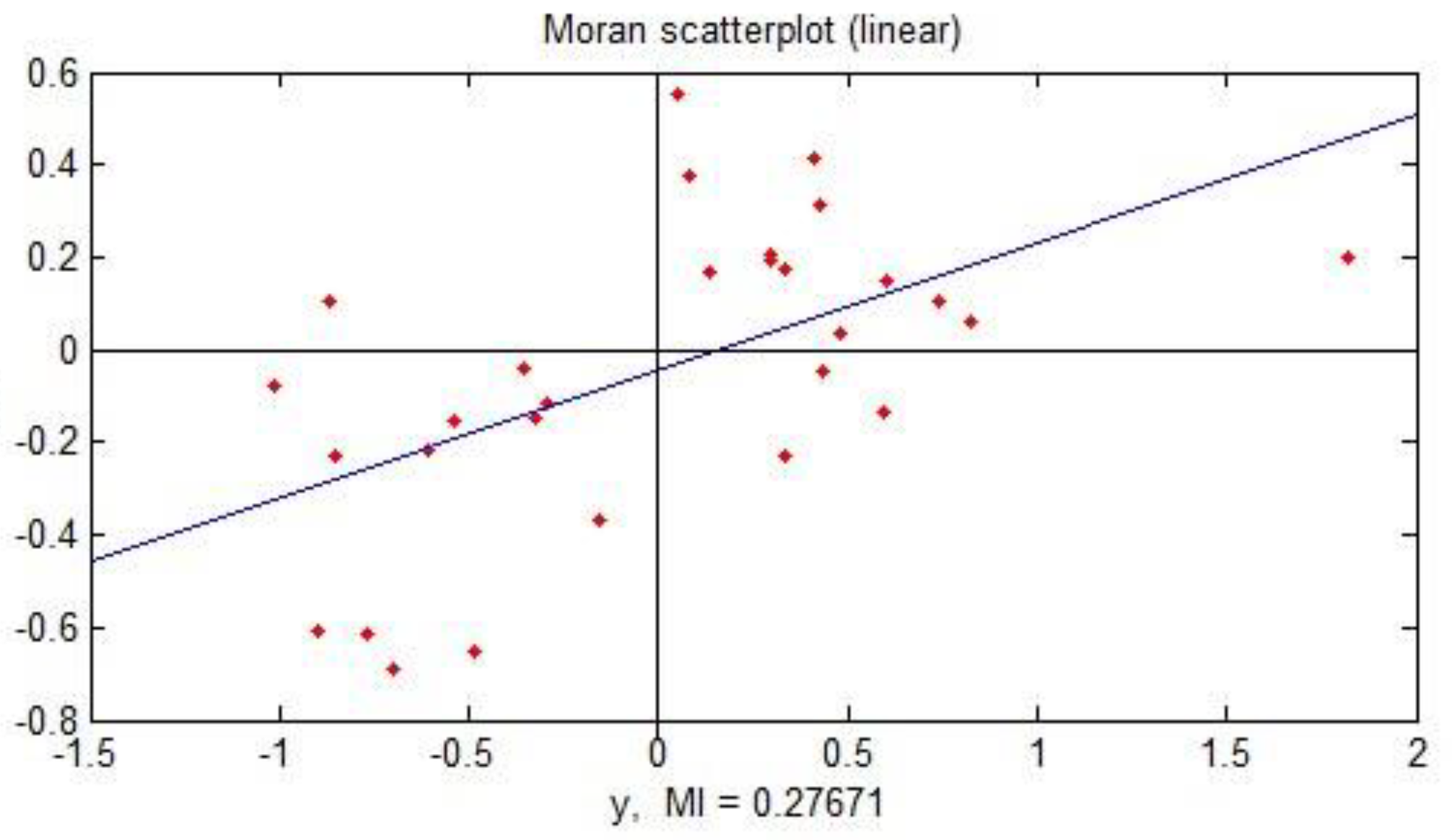

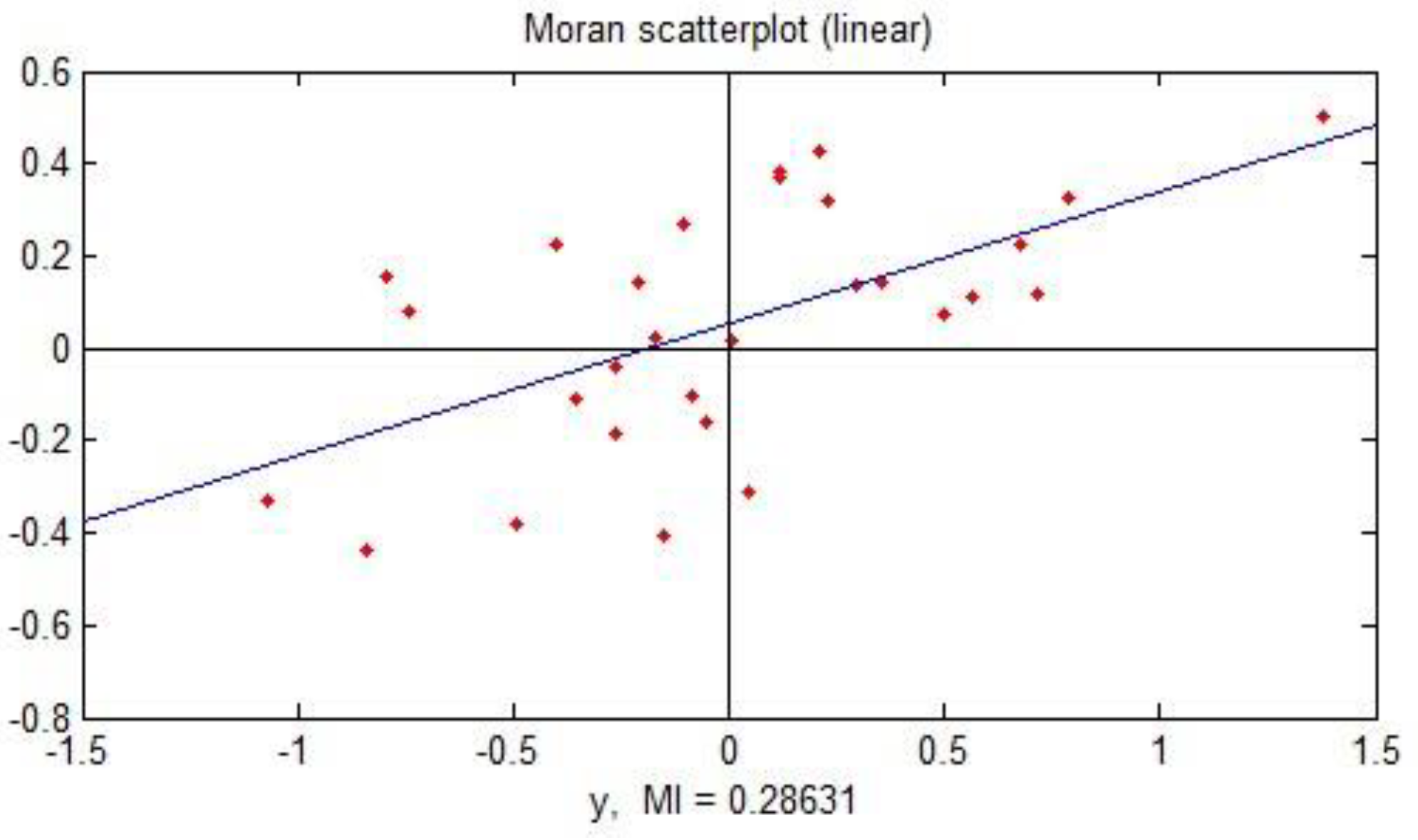
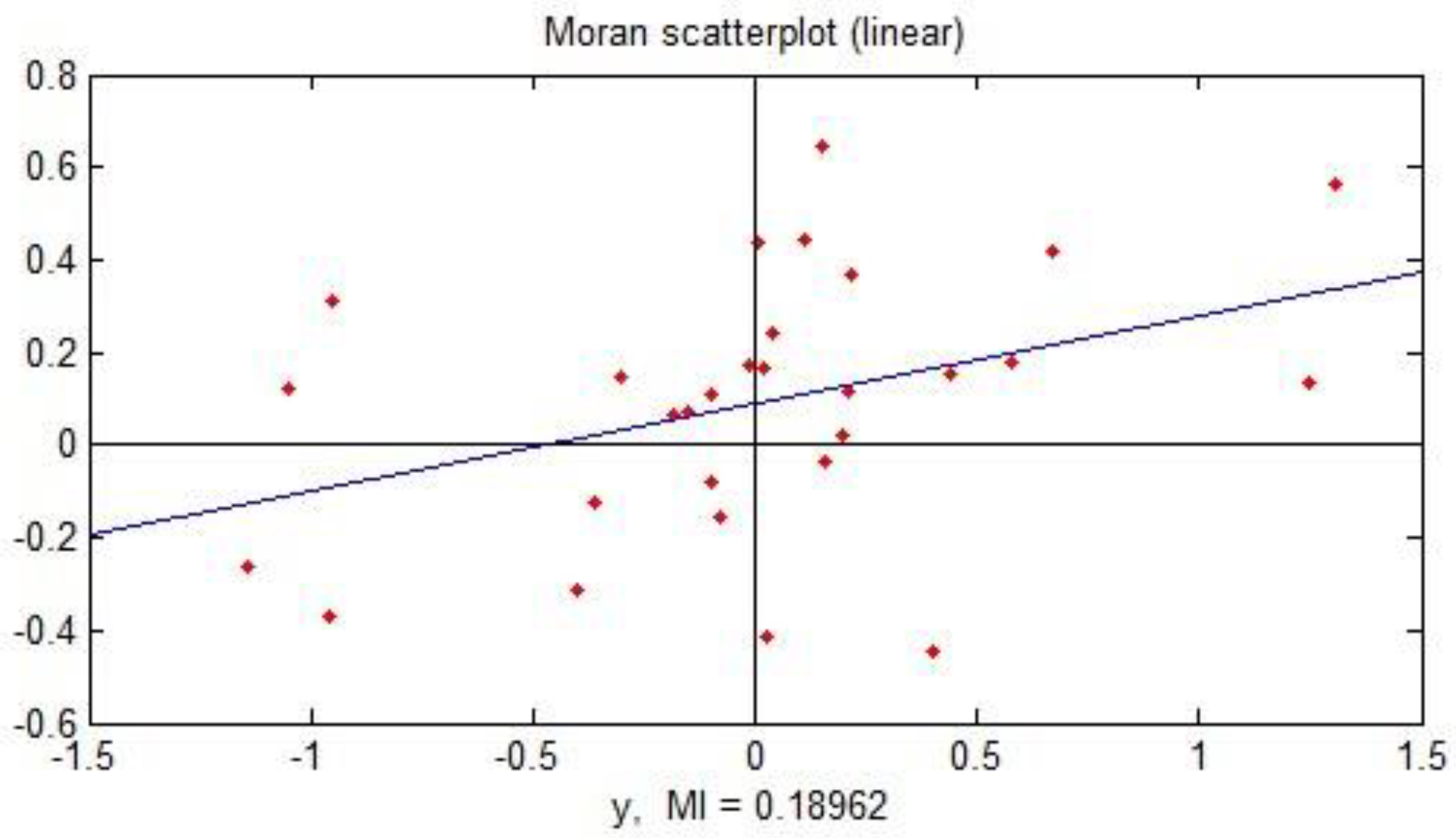
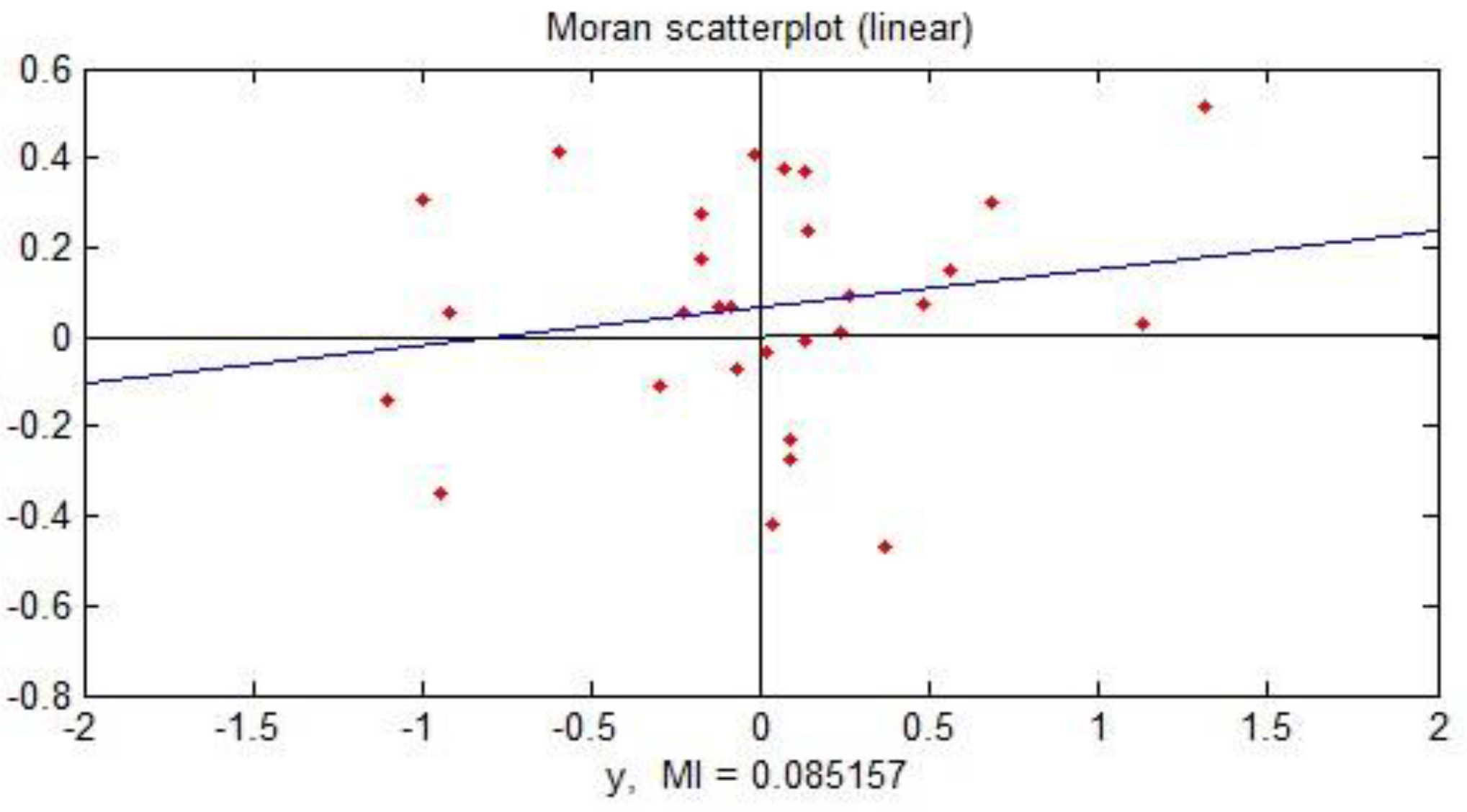
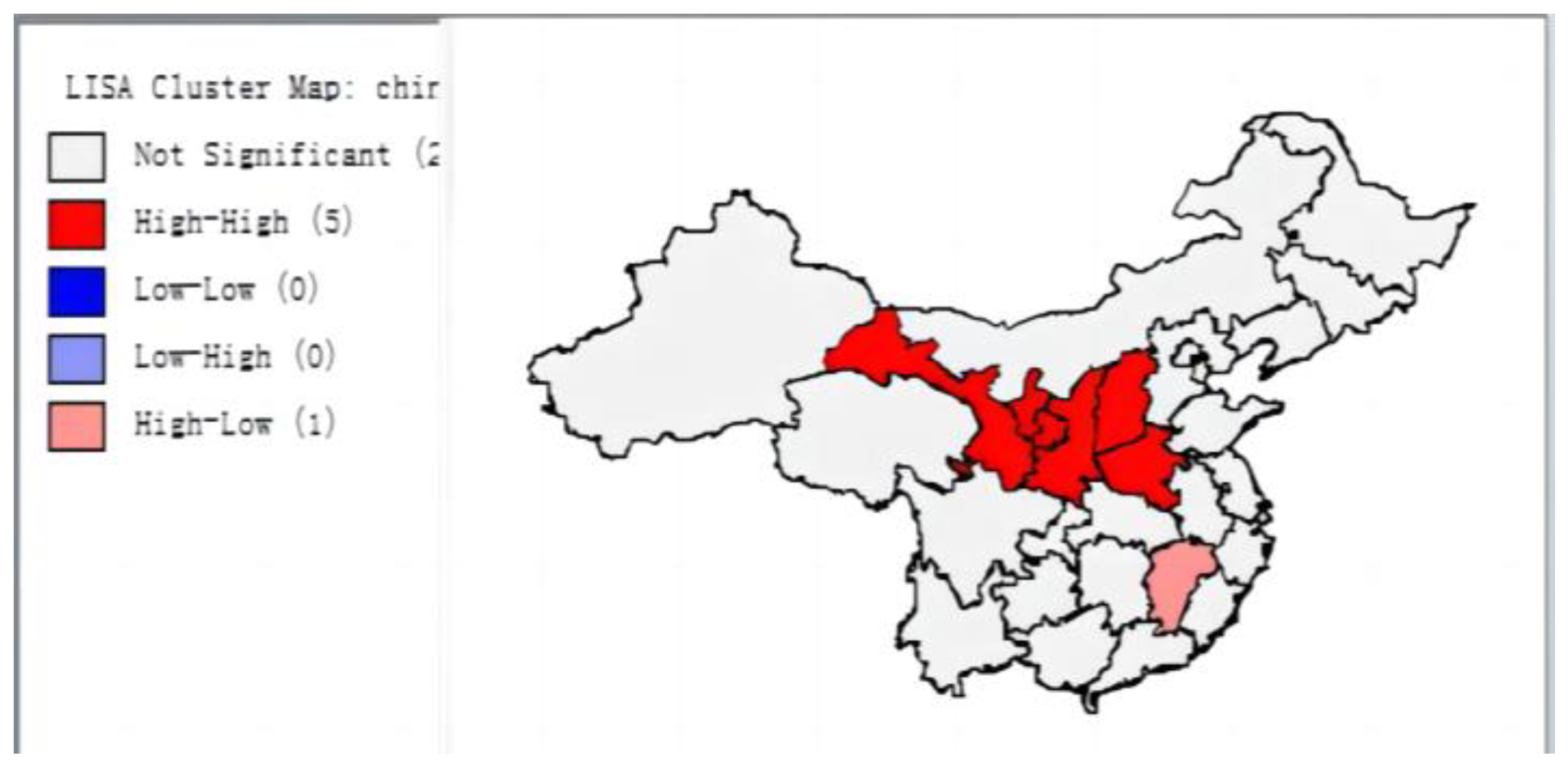
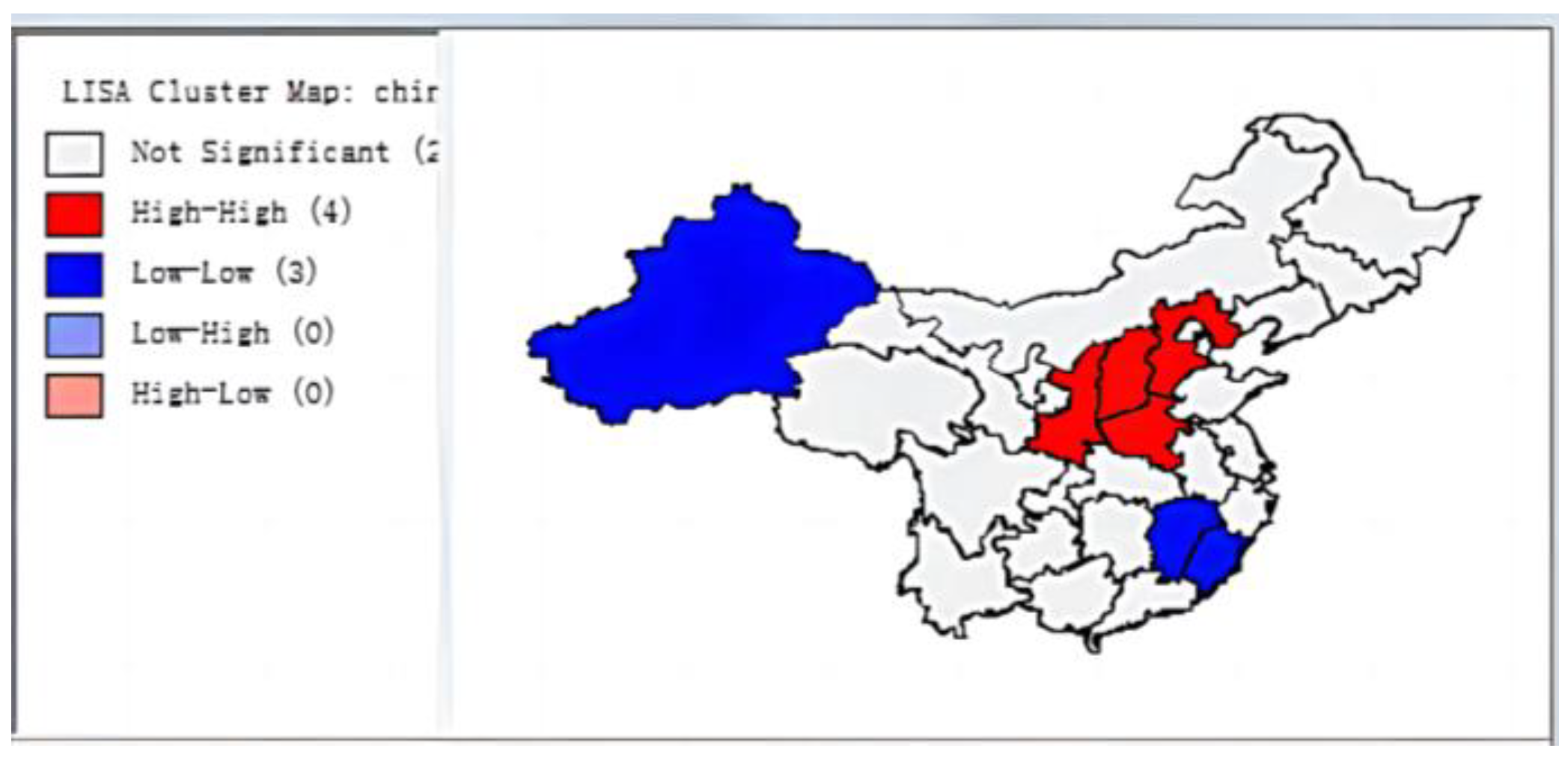
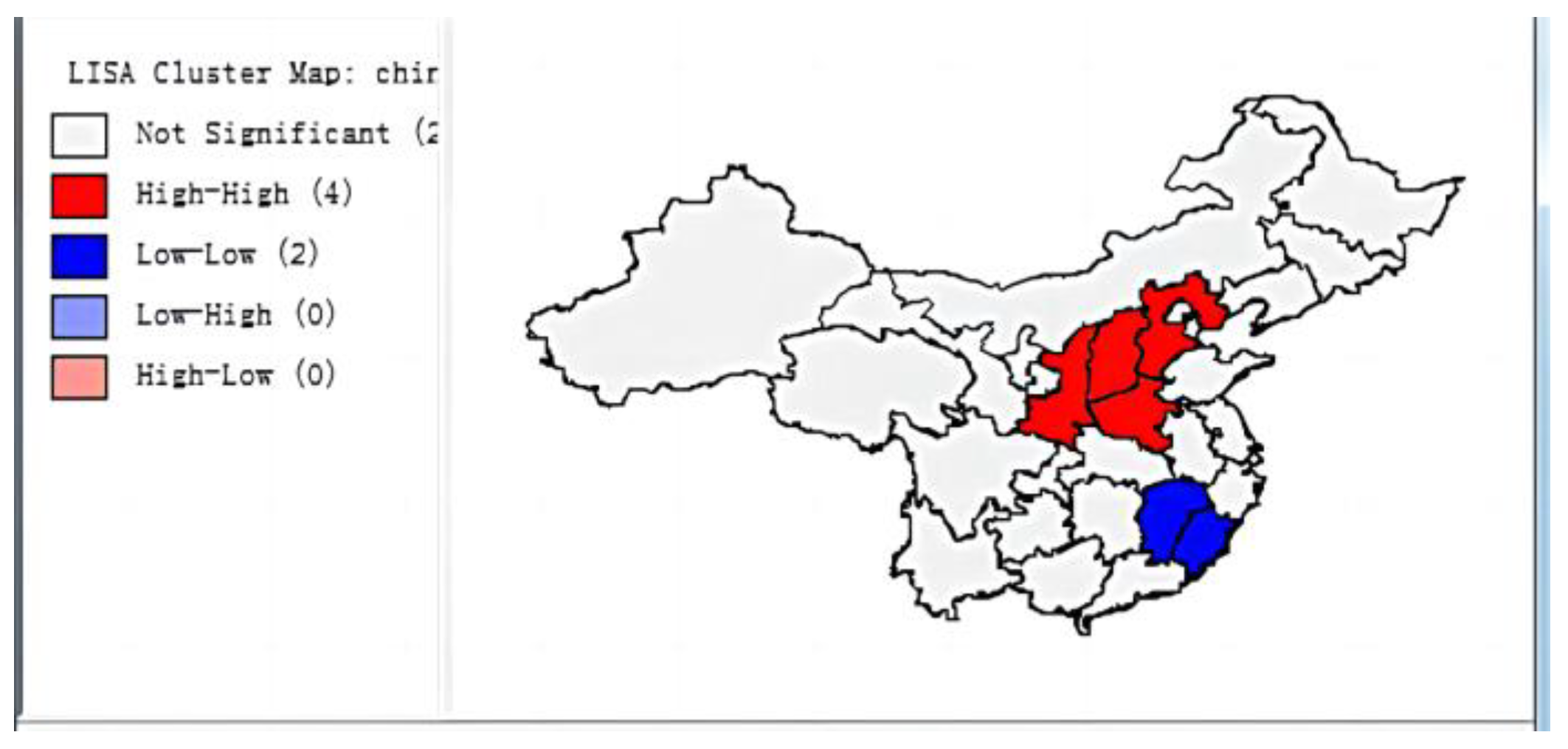
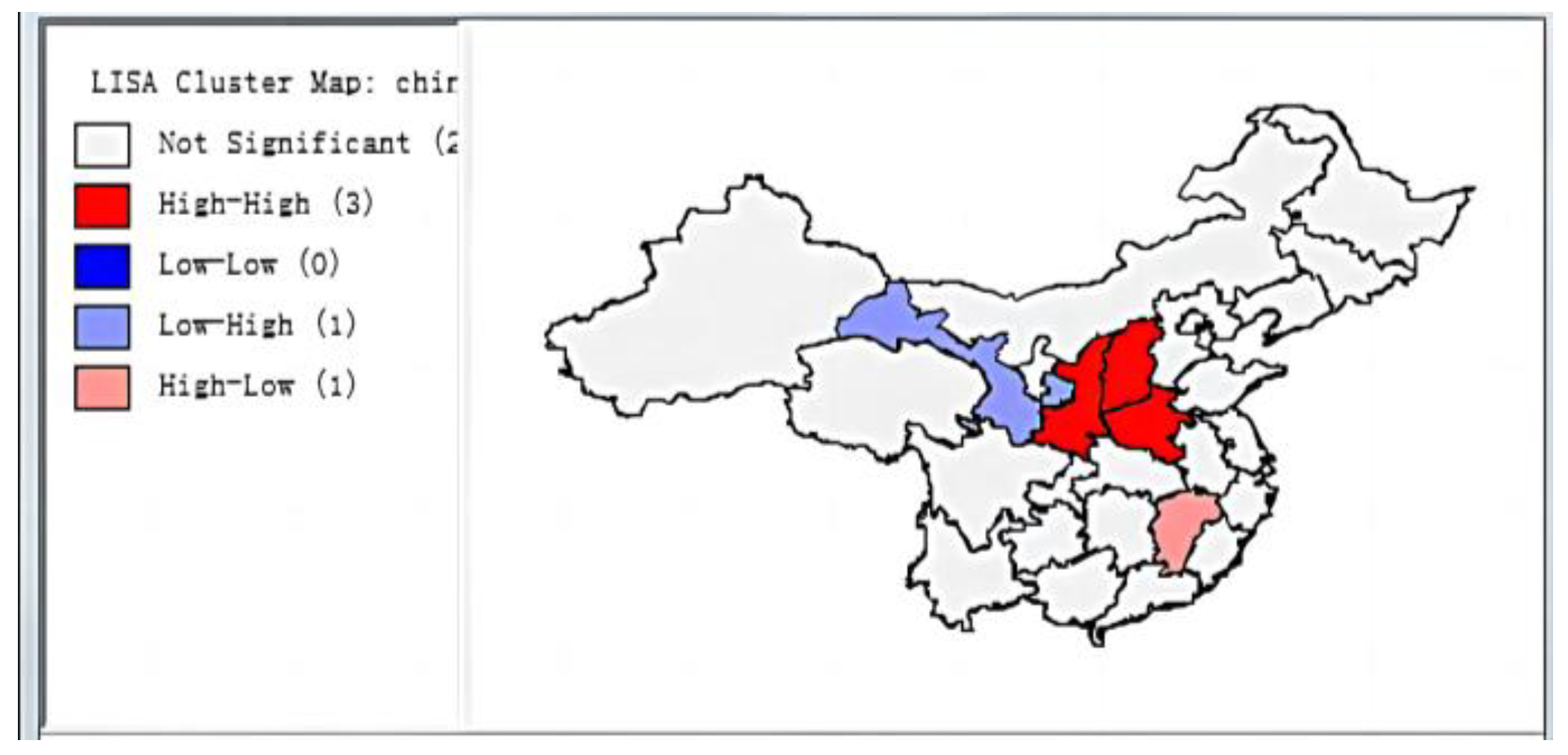
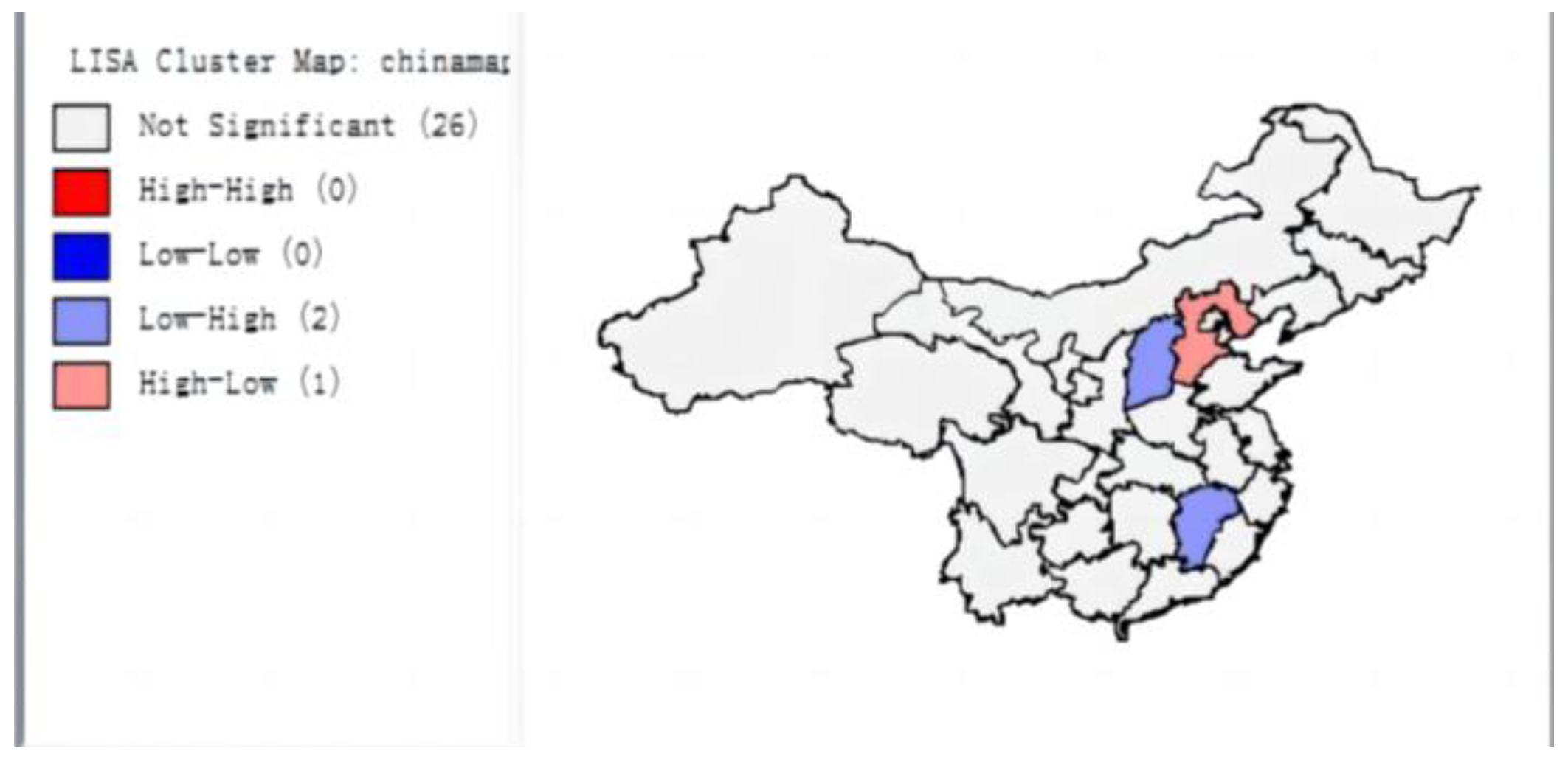
| Year | 2015 | 2016 | 2017 | 2018 | 2019 |
|---|---|---|---|---|---|
| Moran’s I | 0.28 | 0.33 | 0.28 | 0.20 | 0.085 |
| Basic Panel Data Model | Spatial Lag Panel Data Model | Spatial Error Panel Data Model | ||||
| Model 1 | Model 2 | Model 3 | Model 4 | Model 5 | Model 6 | |
| Pooled OLS | Fixed effects ML estimation | Fixed effects ML estimation | Random effects ML estimation | Fixed effects ML estimation | Random effects ML estimation | |
| C | 0.260 | 3.749 | ||||
| 0.000 | 0.000 | |||||
| FD | −0.345 | −0.511 *** | −0.415 *** | 0.081 * | −0.529 *** | 0.108 |
| (0.823) | (0.000) | (0.002) | (0.216) | (0.000) | (0.160) | |
| LNGDP | 0.556 *** | 0.246 | 0.156 | 0.442 *** | 0.158 | 0.826 *** |
| (0.000) | (0.119) | (0.359) | (0.000) | (0.353) | (0.000) | |
| LETTER | 0.019 | 0.037 ** | 0.029 * | 0.709 *** | 0.039 ** | 0.029 |
| (0.000) | (0.021) | (0.100) | (0.269) | (0.052) | (0.156) | |
| LN PEOPLE | 0.087 *** | −2.300 ** | −2.363 ** | −0.096 | −2.455 ** | −0.157 ** |
| (0.006) | (0.015) | (0.019) | (0.212) | (0.025) | (0.044) | |
| LNFDI | 0.0275 | −0.2271 *** | −0.0545 | −0.257 | 0.00527 | −0.0880 |
| (0.267) | (0.082) | (0.6632) | (0.264) | (0.277) | (0.400) | |
| δ | 0.227 ** | 0.264 *** | ||||
| (0.023) | (0.000) | |||||
| λ | 0.213 ** | 0.171 | ||||
| (0.045) | (0.161) | |||||
| Rsquare | 0.209 | 0.471 | 0.853 | 0.798 | 0.846 | 0.772 |
| LM-Lag | Robust LM-Lag | LM-Error | Robust LM-Error |
|---|---|---|---|
| 4.442 | 2.56 | 2.565 | 0.683 |
| 0.035 | 0.01 | 0.109 | 0.409 |
Disclaimer/Publisher’s Note: The statements, opinions and data contained in all publications are solely those of the individual author(s) and contributor(s) and not of MDPI and/or the editor(s). MDPI and/or the editor(s) disclaim responsibility for any injury to people or property resulting from any ideas, methods, instructions or products referred to in the content. |
© 2023 by the authors. Licensee MDPI, Basel, Switzerland. This article is an open access article distributed under the terms and conditions of the Creative Commons Attribution (CC BY) license (https://creativecommons.org/licenses/by/4.0/).
Share and Cite
Gao, H.; Li, F.; Zhang, J.; Sun, Y. A Study of the Strategic Interaction in Environmental Regulation Based on Spatial Effects. Systems 2023, 11, 62. https://doi.org/10.3390/systems11020062
Gao H, Li F, Zhang J, Sun Y. A Study of the Strategic Interaction in Environmental Regulation Based on Spatial Effects. Systems. 2023; 11(2):62. https://doi.org/10.3390/systems11020062
Chicago/Turabian StyleGao, Hewen, Fei Li, Jinhua Zhang, and Yu Sun. 2023. "A Study of the Strategic Interaction in Environmental Regulation Based on Spatial Effects" Systems 11, no. 2: 62. https://doi.org/10.3390/systems11020062





